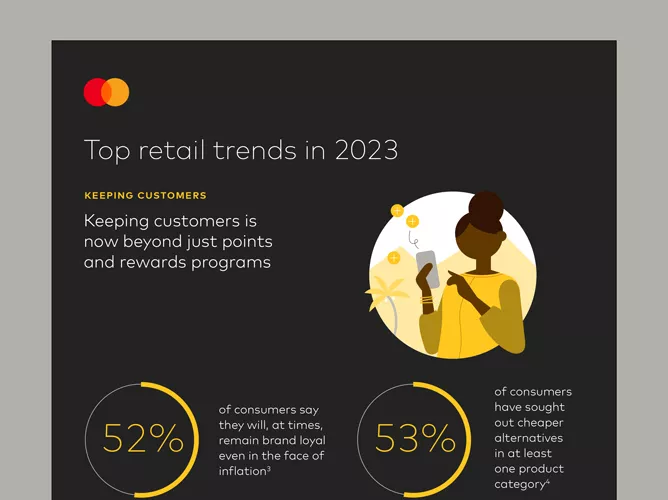November 10, 2023
Retail banking, or consumer banking, used to be a relatively staid affair. Brands were often in a corporate blue color with logotypes in all-caps serif fonts.
Account switching was cumbersome. Customers were often for life. Products were similar across brands.
Successful retail banks shifted from a product-based architecture to a needs-based architecture.
Financial technology (fintech) changed much of that. Banks adopted softer fonts and added purplish hues to their trusted blues. The snazzy colors of emerging digital-only neobanks often shunned blue altogether.
Yet AI or API, open finance or embedded finance, fintech did not really change the underlying banking products. The change came in the delivery. Successful retail banks shifted from a product-based architecture to a needs-based architecture.
The trends that ensue nowadays, such as the six below, often have no dedicated product. When they do, the product benefits lie mostly in customer experience (CX), user experience (UX) and customer relationship management (CRM) rather than in the actual products themselves.
Digitalization or “everyone’s a fintech”
A common perception a few years ago put traditional banks and emerging neobanks on opposite sides of fintech. Banks excelled on the "fin" side but lacked on the "tech" side; neobanks had "tech" but lacked "fin."
The blurring of that distinction, if it ever fully existed, is well underway. More topical now is how Banking as a Service (BaaS) is turning any company that adopts application programming interfaces (APIs) into a fintech company.
Any company adopting an API-based business model may become a fintech company too.
Common BaaS partnerships involve a bank on the backend letting a neobank or payment service provider (PSP) on the frontend offer banking capabilities directly to customers through embedded finance. A more recent development sees tech companies originally outside the fintech space, such as e-commerce marketplaces and rideshare apps, similarly benefitting.
The neobanks and PSPs were already fintech companies before BaaS; the tech companies effectively became fintech companies because of BaaS. Now any company adopting an API-based business model may become a fintech company too. Revenue opportunities are there for banks ready to support the evolution.
Hyper-personalization really is “hyper”
In the 1984 rockumentary “This is Spinal Tap,” the lead guitarist boasts that the volume dials on all his amps go up to eleven and reasons that they must be louder than if they only went up to ten. When asked whether ten could just be made a little louder as the top number, his response is simple: “These go to eleven.”
Advanced data analytics now means an algorithm may sometimes appear to know someone better than they know themselves.
The "hyper" in hyper-personalization may seem similarly absurd. Surely it is just personalization done well. Yet advanced data analytics now means an algorithm may sometimes appear to know someone better than they know themselves in the way it can predict needs and preferences. And in that way at least, data does take personalization above and beyond in the true sense of hyper.
The feat is achieved in two connected ways. Firstly, the pairing of customer data with independently anonymized global transaction data allows “lookalike modeling” to predict which traits of existing customers will best apply to which customers transacting elsewhere.
Secondly, the insights from customer data and transaction data can then provide context-based value to proxy metrics, such as click-through rate (CTR) and cost per click (CPC), from campaign data. A test-and-learn approach, often epitomized by a low-cost approach to experimentation known as “growth hacking”, then allows personalization at every interaction and at every touchpoint.
Human-centered customer service keeps the human in personalization
In 1997, a prescient Canadian bank made two bold moves: it opened a café in one of its physical branches; it launched a digital-only spin-off bank. A split focus across physical and digital might have seemed inadvisable at the time. Later it would be termed “omnichannel.”
As hyper-personalization goes beyond personalization, it is easy to forget the human side. Staples such as brick-and-mortar bank branches can appear anachronistic when everything is digital, and many industry pundits predicted their demise. Other pundits, perhaps more inclined to a conversation over a cup of coffee, more reasonably reference the evolution of retail.
Its split focus across physical and digital would later be termed "omnichannel."
The blurring of the line between online and offline in retail locations is similarly assuring the future of retail bank branches as customers flit between digital and physical interactions. Increasingly they are enjoying a combination of both.
One of the latest examples comes from how Chinese banks often use WeCom, a business spinoff of the social messaging app WeChat, for customer relationship management. Common uses include sharing data-informed discounts at regionally relevant retailers to promote card use or personally engaging with high-value customers to prevent drop off.
“Super app” or just “total relationship banking”?
A crude generalization could put “super apps” on the east of the globe and “total relationship banking” on the west. The banks on each side then look across at each other for models and wonder how to proceed.
Some confusion is understandable. Whether super app or total relationship banking, the overarching purpose is to keep customers within one ecosystem to conveniently meet all their needs with the associated economies of scale. Customers benefit from a one-stop shop with lower prices; providers benefit from increased customer acquisition and engagement.
A crude generalization could put “super apps” on the east of the globe and “total relationship banking” on the west.
The differences are in origin and scope. Super apps began with tech companies in social medial and e-commerce. Embedded finance then allowed the tech companies to move into financial services by offering payments, credit solutions and ultimately bank accounts. Some of Asia’s largest neobanks evolved in that way from social media and e-commerce platforms.
Meanwhile, total relationship banking began with banks rather than neobanks as a way to connect their disparate business lines. Adding total relationship banking to a super app makes sense. The inverse might seem less likely, but the e-commerce marketplaces of buy now, pay later (BNPL) providers suggest otherwise.
Environmental sustainability and the payment network effect
Recycling expired payment cards, switching to more sustainable materials instead of first-use plastic, using virtual cards in digital wallets — all are noble pursuits. Yet a potentially bigger opportunity goes beyond the cards themselves. It harnesses the unified clout of the underlying payment network to take cardholders beyond shared payment experiences into shared consumption choices.
Cardholders can understand how their financial footprints pertain to their carbon footprints.
In 2004, the United Nations coined the acronym ESG in a call for investors to include environmental, social and governance considerations in corporate valuations. Initiatives for the standardized disclosure of sustainability data by businesses have duly followed. Yet, in the consumer space, a model already exists in the carbon calculators that banks can include in their apps.
The calculators combine consumer-permissioned spend data with merchant category codes to provided standardized estimated calculations of carbon emissions generated by purchases. Cardholders can then understand how their financial footprints pertain to their carbon footprints.
Spending tips within the calculator can help cardholders make environmentally responsible choices around sustainable consumption. Further support comes from card-based donations to help cardholders with carbon compensation. They may be simple one-off or recurring donations, or they may be dynamic “round ups” of individual purchases or percentages of total purchases.
Consumer credit risk finds a broader basis for trust
The German word “leihen” is clearly related to the English word “lend.” Yet the distinction is more than just pronunciation. Depending on context, leihen can also mean borrow. It encapsulates a single concept based on credit, which refers to the trust between a lender and a borrower.
Challenging economic conditions can erode that trust, but they need not. Trust implies an intimate relationship based on individual borrower circumstances and dedicated lender responses. However, a dedicated focus on the individual can fail to appreciate a broader perspective.
Breadth comes from an appreciation of long-term economic fluctuations and cross-market dynamism. Lenders lose when their borrowers lose, and accurate segmentation of borrowers by lenders requires data on borrower resilience over extended periods and on borrower behavior across various markets.
It encapsulates a single concept based on credit, which refers to the trust between a lender and a borrower.
Further trust in turbulent times comes from alternative credit scoring through consumer-permissioned access to broader financial and personal data. Neobanks often use this scoring for financial inclusion, and a particularly powerful combination comes from layering alternative credit scoring on top of traditional scoring.
A final thought: What is retail banking or consumer banking?
In a sea of corporate blue, the retail part of retail banking is easy to gloss over. More descriptive is the term “consumer” in the alternative name consumer banking as a counterpart to commercial banking for business clients.
The shift to a needs-based architecture instead of a product-based architecture cements retail banking as the moniker of choice. A better product is generally preferable to an inferior one. But in a sea of competition rather than corporate blue, success may sooner come from the timely satisfaction of a particular consumer need than from specific product merits alone.
Request a demo to learn more.















